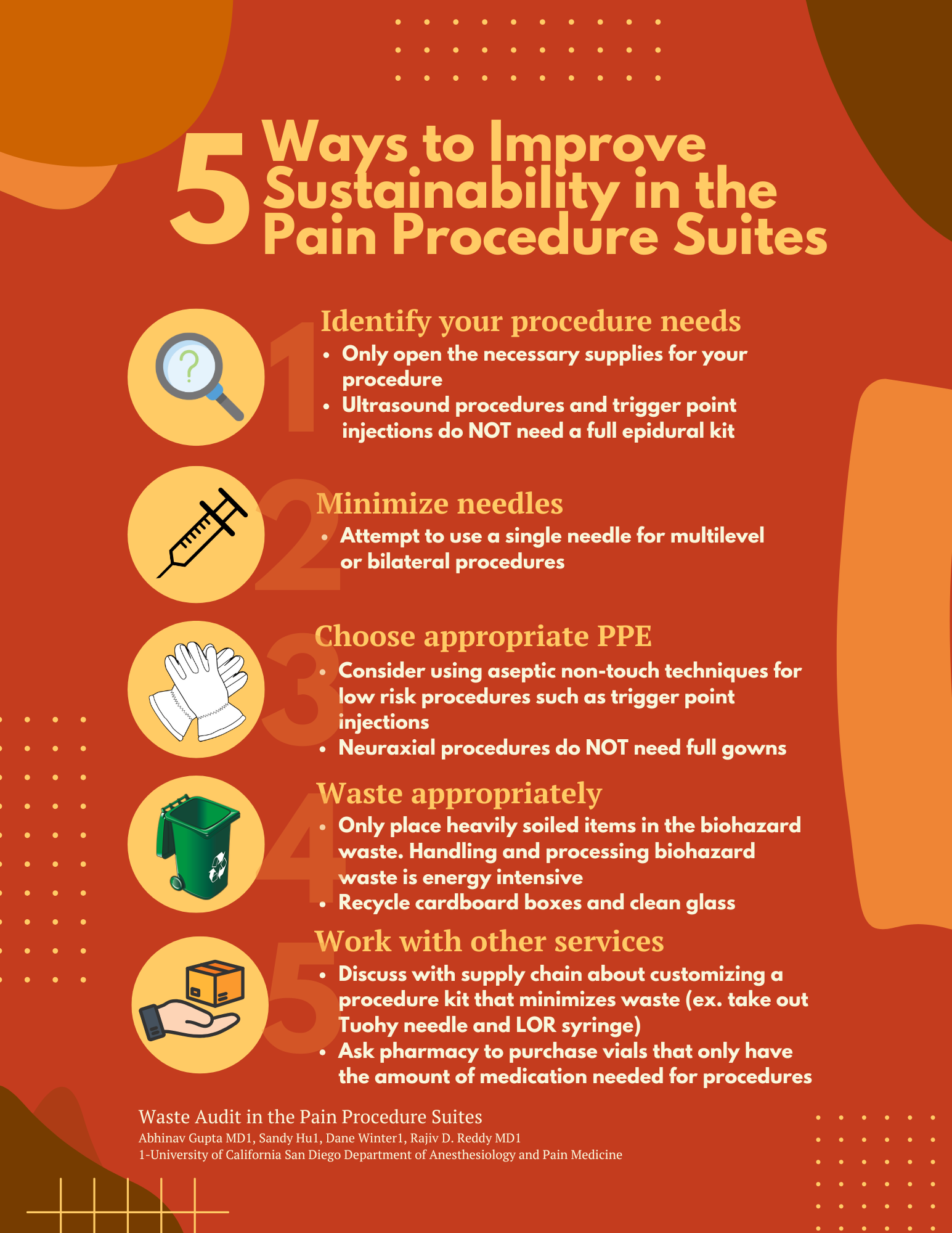Waste Audit in Pain Procedure Suites
Cite as: Gupta A, Hu S, Winter D. Waste audit in pain procedure suites. ASRA Pain Medicine News 2024;49. https://doi.org/10.52211/asra110124.015.
The climate crisis is now the greatest public health crisis of our century. As pain medicine physicians and anesthesiologists, we are tasked with treating individual patients in our clinics and hospitals. However, the healthcare sector plays a considerable role in exacerbating the climate crisis as one of the largest waste and greenhouse gas (GHG) generators.
The healthcare sector accounts for 5% of global net greenhouse gas emissions, with the United States being the largest contributor, responsible for 7.6% of the global healthcare climate footprint.1,2 The manufacturing, disposal, and transporting of pharmaceuticals, medical devices, equipment, and instruments contributes to 71% of total healthcare GHG emissions.1 Hospitals produce more than 29 pounds of daily waste per bed, amounting to 5 million tons of waste annually.2 Given the substantial amount of waste produced and its significant contribution to the healthcare climate footprint, changes need to be made to reduce the consumption of waste. Efforts have been made to audit the amount of waste produced in various clinical settings; however, waste audits in pain medicine have been lacking.
We conducted two, 5-day waste audits of our three outpatient pain procedure suites at the University of California San Diego and identified potential areas for environmentally sustainable intervention. During the audit, we weighed the total amount of waste per day and sorted it into categories, including blue wrap, cleaning supplies, medication-related supplies, packaging, personal protective equipment, procedure-related equipment, recycling, unused material, used drapes, used gauze, used kit supplies, sterile glove packaging paper, and other trash.
Our audit showed that the pain medicine suites produced 13.60 kg of daily waste (excluding pharmaceutical and sharp waste). We identified a significant number of unused kit items; therefore, we recommend only opening a whole kit if every item in the kit is required. We worked with our supply chain to remove some items in the kit that were commonly disposed of, such as the Tuohy needle and loss of resistance syringe. Personal protective equipment comprised a surprisingly large portion of the waste; as a result, we suggest considering non-sterile gloves and using aseptic non-touch techniques for low-risk procedures, such as trigger point injections and ultrasound-guided peripheral injections. Only heavily soiled items should be placed in biohazard bins as processing this waste is energy-intensive and costly.3 Finally, we suggest considering the minimum number of needles necessary for the procedure, especially in multilevel or bilateral procedures.
Our waste audit has identified wasteful practices and enabled reflection on reducing resource utilization that we hope can be implemented in many healthcare facilities.





References
- Karliner J, Slotterback S, Boyd R, et al. Health Care’s Climate Footprint. Reston, VA: Heath Care Without Harm, 2019. https://global.noharm.org/sites/default/files/documents-files/5961/HealthCaresClimateFootprint_092319.pdf
- Lenzen M, Malik A, Li M, et al. The environmental footprint of health care: a global assessment. Lancet Planet Health 2020;4(7):271-9. https://doi.org/10.1016/S2542-5196(20)30121-2
- Zikhathile T, Atagana H, Bwapwa J, et al. A review of the impact that healthcare risk waste treatment technologies have on the environment. Int J Environ Res Public Health 2022;19(19):11967. https://doi.org/10.3390/ijerph191911967